Related Research Articles

Ecdysis is the moulting of the cuticle in many invertebrates of the clade Ecdysozoa. Since the cuticle of these animals typically forms a largely inelastic exoskeleton, it is shed during growth and a new, larger covering is formed. The remnants of the old, empty exoskeleton are called exuviae.
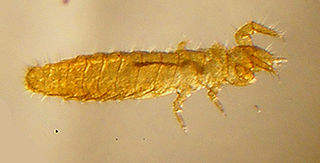
The Protura, or proturans, and sometimes nicknamed coneheads, are very small, soil-dwelling animals, so inconspicuous they were not noticed until the 20th century. The Protura constitute an order of hexapods that were previously regarded as insects, and sometimes treated as a class in their own right.

The black-necked grebe or eared grebe is a member of the grebe family of water birds. It was described in 1831 by Christian Ludwig Brehm. Its breeding plumage features distinctive ochre-coloured feathers which extend behind its eye and over its ear coverts. The rest of the upper parts, including the head, neck, and breast, are coloured black to blackish brown. The flanks are tawny rufous to maroon-chestnut, and the abdomen is white. In its non-breeding plumage, this bird has greyish-black upper parts, including the top of the head and a vertical stripe on the back of the neck. The flanks are also greyish-black. The rest of the body is a white or whitish colour. The juvenile has more brown in its darker areas. This species is present in parts of Africa, Eurasia, and the Americas.

The spotted redshank is a wader (shorebird) in the large bird family Scolopacidae. The genus name Tringa is the Neo-Latin name given to the green sandpiper by Aldrovandus in 1599 based on Ancient Greek trungas, a thrush-sized, white-rumped, tail-bobbing wading bird mentioned by Aristotle. The specific erythropus is from Ancient Greek eruthros, "red", and pous, "foot".

In biology, moulting, or molting, also known as sloughing, shedding, or in many invertebrates, ecdysis, is a process by which an animal casts off parts of its body to serve some beneficial purpose, either at specific times of the year, or at specific points in its life cycle.

Angora hair or Angora fibre is the downy coat produced by the Angora rabbit. While the names of the source animals are similar, Angora fibre is distinct from mohair, which comes from the Angora goat. The cloth produced has sometimes been named Angola fabric. Angora fibre is also distinct from cashmere, which comes from the cashmere goat. Angora is known for its softness, thin fibres, and what knitters refer to as a halo (fluffiness). It is also known for its silky texture. It is much warmer and lighter than wool due to the hollow core of the angora fibre. It also gives the wool its characteristic floating feel.

An instar is a developmental stage of arthropods, such as insects, which occurs between each moult (ecdysis) until sexual maturity is reached. Arthropods must shed the exoskeleton in order to grow or assume a new form. Differences between instars can often be seen in altered body proportions, colors, patterns, changes in the number of body segments or head width. After shedding their exoskeleton (moulting), the juvenile arthropods continue in their life cycle until they either pupate or moult again. The instar period of growth is fixed; however, in some insects, like the salvinia stem-borer moth, the number of instars depends on early larval nutrition. Some arthropods can continue to moult after sexual maturity, but the stages between these subsequent moults are generally not called instars.
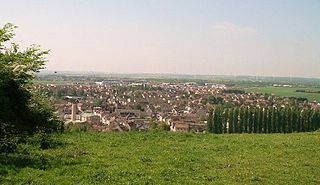
Argences is a commune in the Calvados department in the Normandy region of north-western France. It is in the urban area of Caen, 15 kilometres from the city.
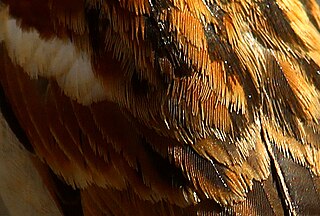
Plumage is a layer of feathers that covers a bird and the pattern, colour, and arrangement of those feathers. The pattern and colours of plumage differ between species and subspecies and may vary with age classes. Within species, there can be different colour morphs. The placement of feathers on a bird is not haphazard but rather emerges in organized, overlapping rows and groups, and these feather tracts are known by standardized names.

Incisivosaurus is a genus of small, probably herbivorous theropod dinosaurs from the early Cretaceous Period of what is now the People's Republic of China. The first specimen to be described, IVPP V13326, is a skull that was collected from the lowermost levels of the Yixian Formation in the Sihetun area, near Beipiao City, in western Liaoning Province. The most significant, and highly unusual, characteristic of this dinosaur is its apparent adaptation to an herbivorous or omnivorous lifestyle. It was named for its prominent, rodent-like front teeth, which show wear patterns commonly found in plant-eating dinosaurs. The specific name gauthieri honors Dr. Jacques Gauthier, a pioneer of the phylogenetic method of classification.
Moulting is the manner in which an animal routinely casts off a part of its body.
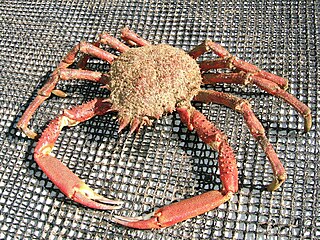
Maja squinado is a species of migratory crab found in the Mediterranean Sea. The appearance of the European spider crab is similar to the much larger Japanese spider crab, although the European spider crab belongs to the family Majidae, and the Japanese spider crab belongs to a different family of crabs, the Macrocheiridae.

Flight feathers are the long, stiff, asymmetrically shaped, but symmetrically paired pennaceous feathers on the wings or tail of a bird; those on the wings are called remiges, singular remex, while those on the tail are called rectrices, singular rectrix. The primary function of the flight feathers is to aid in the generation of both thrust and lift, thereby enabling flight. The flight feathers of some birds perform additional functions, generally associated with territorial displays, courtship rituals or feeding methods. In some species, these feathers have developed into long showy plumes used in visual courtship displays, while in others they create a sound during display flights. Tiny serrations on the leading edge of their remiges help owls to fly silently, while the extra-stiff rectrices of woodpeckers help them to brace against tree trunks as they hammer on them. Even flightless birds still retain flight feathers, though sometimes in radically modified forms.

Eugène Le Moult was a French naturalist and entomologist specialised in butterflies; hunter, businessman and collector.

Hauling out is a behaviour associated with pinnipeds temporarily leaving the water. Hauling-out typically occurs between periods of foraging activity. Rather than remain in the water, pinnipeds haul out onto land or sea ice for reasons such as reproduction and rest. Hauling out is necessary in seals for mating and giving birth. Other benefits of hauling out may include predator avoidance, thermoregulation, social activity, parasite reduction and rest.

Louis Elliot Moult is an English professional footballer who plays as a striker for Scottish Premiership club Dundee United.
Kevin Wilkin is an English manager and former professional footballer. He is the manager of AFC Telford United.
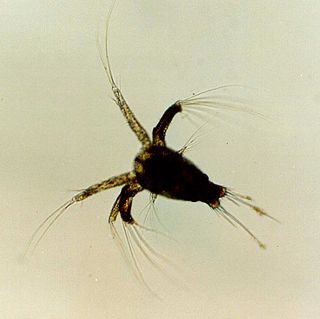
Crustaceans may pass through a number of larval and immature stages between hatching from their eggs and reaching their adult form. Each of the stages is separated by a moult, in which the hard exoskeleton is shed to allow the animal to grow. The larvae of crustaceans often bear little resemblance to the adult, and there are still cases where it is not known what larvae will grow into what adults. This is especially true of crustaceans which live as benthic adults, more-so than where the larvae are planktonic, and thereby easily caught.

Moulting Lagoon Important Bird Area is a composite wetland site in eastern Tasmania, Australia. It comprises two adjacent and hydrologically continuous wetlands – Moulting Lagoon and the Apsley Marshes – at the head of Great Oyster Bay, near the base of the Freycinet Peninsula, between the towns of Swansea and Bicheno. Both components of the site are listed separately under the Ramsar Convention as wetlands of international significance. Moulting Lagoon is so named because it is a traditional moulting place for black swans. It is an important site for waterbirds.

Moult-Chicheboville is a commune in the department of Calvados, northwestern France. The municipality was established on 1 January 2017 by merger of the former communes of Moult and Chicheboville. Moult-Argences station has rail connections to Caen and Lisieux.
References
- ↑ "Roger Moult". ESPN Cricinfo. Retrieved 12 December 2020.